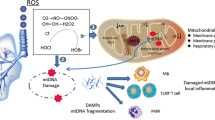Abstract
Conflicting evidence has been reported as to whether nitric oxide (NO) possesses anti-inflammatory or inflammatory properties. Data are presented indicating thatin vitro orin vivo exposure to selected occupational dusts, i.e., crystalline silica, organic dust contaminated with endotoxin, or asbestos, results in upregulation of inducible nitric oxide synthase (iNOS) and the production of NO by alveolar macrophages and pulmonary epithelial cells. Nitric oxide production is associated temporally and anatomically with pulmonary damage, inflammation, and disease progression in response to occupational dusts. Blockage of inducible nitric oxide synthase by administration of NOS inhibitors or in iNOS knockout mice decreases the magnitude of injury and inflammation followingin vivo exposure to silica, endotoxin, or asbestos. Therefore, NO may play an important role in the initiation and progression of pneumoconiosis.
Similar content being viewed by others
REFERENCES
Driscoll, K. E., and Guthrie, G. D. (1997) inComprehensive Toxicology. Vol. 8.Toxicology of the Respiratory System (Roth, R. A., ed.) Elsevier Science, Inc., New York, pp. 373–391.
IARC (1997)IARC Monograph Evaluating Carcinogenic Risks in Humans,68, 41–242.
Castranova, V., and Vallyathan, V. (2000)Environ. Health Perspect.,108(Suppl. 4), 675–684.
Shi, X., Castranova, V., Halliwell, B., and Vallyathan, V. (1998)J. Toxicol. Environ. Health (Pt. B),1, 181–197.
Castranova, V. (1994)Environ. Health Perspect.,102(Suppl. 10), 65–68.
Rojanasakul, Y., Ye, J., Chen, F., Wang, L., Cheng, N., Castranova, V., Vallyathan, V., and Shi, X. (1999)Mol. Cell. Biochem.,200, 119–125.
Ding, M., Shi, X., Lu, Y., Huang, C., Leonard, S., Roberts, J., Antonini, J., Castranova, V., and Vallyathan, V. (2001)J. Biol. Chem.,276, 9108–9114.
Chen, F., Castranova, V., Shi, X., and Demers, L. M. (1999)Clin. Chem.,45, 7–17.
Rylander, R. (1997) inComprehensive Toxicology. Vol. 8.Toxicology of the Respiratory System (Roth, R. A., ed.) Elsevier Science, Inc., New York, pp. 415–424.
Merchant, J. A. Halprin, G. M., Hudson, A. R., Kilburn, K. H., McKenzie, W. N., Hurst, D. J., and Bermazohn, P. (1975)Arch. Environ. Health,30, 222–229.
Castranova, V., Robinson, V. A., and Frazer, D. G. (1996)Environ. Health Perspect.,104(Suppl. 1), 41–53.
Dement, J. M., Merchant, J. A., and Green, F. H. Y. (1987) inOccupational Respiratory Diseases (Merchant, J. A., Boehlecke, B. A., Taylor, G., and Pickett-Harner, M., eds.) DHHS (NIOSH) Publication No. 86-102, pp. 287–327.
Castranova, V. (1998)Appl. Occup. Environ. Hyg.,13, 613–616.
Brody, A. R. (1997) inComprehensive Toxicology. Vol. 8.Toxicology of the Respiratory System (Roth, R. A., ed.) Elsevier Science, Inc., New York, pp. 393–413.
Ding, M., Dong, Z., Chen, F., Pack, D., Ma, W.-Y., Ye, J., Shi, X., Castranova, V., and Vallyathan, V. (1999)Cancer Res.,59, 1884–1889.
Van der Vliet, A., Eiserich, J. P., and Halliwell, B. (1997)J. Biol. Chem.,272, 7617–7625.
Haddad, I. Y. (1996)Am. J. Physiol.,270, L898–L906.
Haddad, I. Y. (1996)Am. J. Physiol.,270, L281–L288.
Hogg, N., and Kalyanaraman, B. (1999)Biochim. Biophys. Acta,1411, 378–384.
Szabo, C., and Ohshima, H. (1997)Nitric Oxide,1, 373–385.
Chen, F., Kuhn, D. C., Sun, S. C., Gaydos, L. J., and Demers, L. M. (1995)Biochem. Biophys. Res. Commun.,214, 839–846.
Huffman, L. J., Judy, D. J., and Castranova, V. (1998)J. Toxicol. Environ. Health (Pt. A),53, 29–46.
Kanj, R., Kang, J., and Castranova, V. (2002)FASEB J.,16, A861.3.
Blackford, J. A., Antonini, J. M., Castranova, V., and Day, R. D. (1994)Am. J. Respir. Cell Mol. Biol.,11, 426–431.
Castranova, V., Pailes, W. H., Judy, D. J., and Huffman, L. J. (1994)FASEB J.,8, A854.
Porter, D. W., Millecchia, L., Robinson, V. A., Hubbs, A., Willard, P., Pack, D., Ramsey, D., McLaurin, J., Khan, A., Landsittel, D., Teass, A., and Castranova, V. (2002)Am. J. Physiol: Lung Cell Mol. Physiol.,283, L485–L493.
Gutierrez, H. H., Pitt, B. R., Schwarz, M., Watkins, S. C., Lowenstein, C., Caniggia, I., Chumley, P., and Freeman, B. A. (1995)Am. J. Physiol.: Lung Cell Mol. Physiol.,268, L501–L508.
Huffman, L. J., Judy, D. J., Robinson, V. A., and Castranova, V. (1997)Inhal. Toxicol.,9, 567–579.
Thomas, G., Ando, T., Verma, K., and Kagan, E. (1994)Am. J. Respir. Cell Mol. Biol.,11, 707–715.
Mongan, L. C., Jones, T., and Patrick, G. (2000)Cytokine,12, 1243–1247.
Chao, C. C., Park, S. H., and Aust, A. E. (1996)Arch. Biochem. Biophys.,326, 152–157.
Iguchi, H., Kojo, S., and Ikeda, M. (1996)J. Appl. Toxicol.,16, 309–315.
Tanaka, S., Choe, N., Hemenway, D. R., Zhu, S., Matalon, S., and Kagan, E. (1998)J. Clin. Invest.,102, 445–454.
Matthews, J. R., Botting, C. H., Panico, M., Morris, H. R., and Hay, R. T. (1996)Nucleic Acids Res.,24, 2236–2242.
Peng, H. B., Libby, P., and Liao, J. K. (1995)J. Biol. Chem.,270, 14214–14219.
Raychaudhuri, B., Dweik, R., Connors, M. J., Buhrow, L., Malur, A., Drazha, J., Arroligi, A., Erzurum, S. C., Kavurum, M. S., and Thomassen, M. J. (1999)Am. J. Respir. Cell Mol. Biol.,21, 311–316.
Thomassen, M. J., Buhrow, L. T., Connors, M. J., Kaneko, F. T., Erzurum, S. C., and Kavuru, M. S. (1997)Am. J. Respir. Cell Mol. Biol.,17, 279–283.
Kang, J. L., Park, W., Pack, I. S., Lee, H. S., Kim, M. J., Lim, C.-M., and Koh, Y. (2002)J. Appl. Physiol.,92, 795–801.
Kang, J. L., Lee, K., and Castranova, V. (2000)Mol. Cell. Biochem.,215, 1–9.
Blackford, J. A., Jones, W., Dey, R. D., and Castranova, V. (1997)J. Toxicol. Environ. Health,51, 203–218.
Castranova, V., Huffman, L. J., Judy, D. J., Bylander, J. E., Lapp, L. N., Weber, S. L., Blackford, J. A., and Dey, R. D. (1998)Environ. Health Perspect.,106 (Suppl. 5), 1165–1169.
Srivastava, K. D., Rom, W. N., Jagirdar, J., Yie, T.-A., Gordon, T., and Tchou-Wong, K.-M. (2002)Am. J. Respir. Crit. Care Med.,165, 527–533.
Mikawa, K., Nishina, K., Tamada, M., Takao, Y., Maekawa, N., and Obara, H. (1998)Crit. Care Med.,26, 905–911.
Kristof, A. S., Goldberg, P., Laubach, V., and Hussain, S. N. (1998)Am. J. Respir. Crit. Care Med.,158, 1883–1889.
Quinlan, T. R., BeruBe, K. A., Hacker, M. P., Taatjes, D. J., Timblin, C. R., Goldberg, J., Kimberly, P., O'Shaugnessy, P. O., Hemenway, D., Torino, J., Jiminez, L. A., and Mossman, B. T. (1998)Free Rad. Biol. Med.,24, 778–788.
Dorger, M., Allmeling, A.-M., Kiefmann, R., Munzing, S., Messmer, K., and Krombach, F. (2002)Toxicol. Appl. Pharmacol.,181, 93–105.
Author information
Authors and Affiliations
Rights and permissions
About this article
Cite this article
Castranova, V. Role of Nitric Oxide in the Progression of Pneumoconiosis. Biochemistry (Moscow) 69, 32–37 (2004). https://doi.org/10.1023/B:BIRY.0000016348.34175.53
Issue Date:
DOI: https://doi.org/10.1023/B:BIRY.0000016348.34175.53




